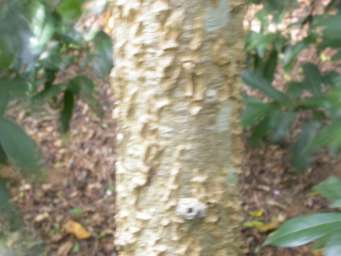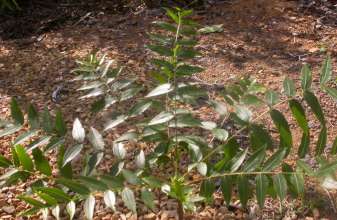Kirkia acuminata
Kirkia acuminata Oliv.
Family: Kirkiaceae
Common names: white seringa (Eng.); witsering (Afr.); mvumayila (Tsonga); modumela (Tswana ); mubvumala (Venda)
SA Tree No: 267
Introduction
This splendid tree does not yet enjoy the fame it deserves, but it is a good choice for those gardeners who prefer something different. It was selected as one of the SA Trees of the Year for 2004.

Description
Description
This is a straight-stemmed tree with a fine, round , leafy crown. It grows from 6 to 18 m high with a trunk diameter of 0.8 m. The leaves are sticky when young, colouring splendidly to gold and red in autumn. The leaf is compound with 6-10 leaflets and one terminal one. The narrowly ovate leaflets are 20-80 x 10-25 mm, with or without hairs. The apex is narrowly tapering to a long point.

Kirkia acuminata flowers from October to December with small greenish cream flowers. The fruits are thinly woody capsules of about 10-20 x 6-10 mm that are 4-angled, and split into four seed pods when mature. Each seed pod contains a seed. The wood is yellowish brown, light and soft.
Distribution and habitat
Distribution description
Kirkia acuminata extends from Gauteng, Botswana, Namibia, and to the north in Tanzania. It grows in the bushveld and lowveld of Gauteng in deep, sandy soil or on rocky hills.
Derivation of name and historical aspects
History
The genus Kirkia is named in honour of Sir John Kirk, a famous explorer and a naturalist. The specific epithet acuminata probably comes from the narrowly tapering apex to a long point (acuminate).
Uses
Use
According to Palmer & Pitman (1972), the white seringa is regarded as a sacred tree in some places in Zimbabwe. The Zimbabwean women also use the bark of the tree for weaving. In Gauteng, white seringa is planted around enclosures for livestock (kraals).
Growing Kirkia acuminata
Grow
This tree is easily propagated from seed and from truncheons. If given well-drained soil in a warm, sheltered position, it will do well in cultivation. It is a relatively fast grower. White seringa can tolerate drought, but it is sensitive to frost, making it a better choice for warmer gardens.
References
- Germishuizen, G., Meyer, N.L., Steenkamp, Y. & Keith, M. (eds) 2006. A Checklist of South African plants. Southern African Botanical Diversity Network Report No. 41. SABONET, Pretoria.
- Palmer, E. & Pitman, N. 1972. Trees of southern Africa, vol. 2. Balkema, Cape Town.
- Ross, J.H. 1970. Kirkia wilmsii. The Flowering Plants of Africa 40: t. 1590.
- Van Wyk, B. & Van Wyk, P. 1997. Field guide to trees of southern Africa. Struik, Cape Town.
Credits
Giles Mbambezeli
Kirstenbosch National Botanical Garden
May 2004
Plant Attributes:
Plant Type: Tree
SA Distribution: Limpopo, Mpumalanga
Soil type: Sandy, Loam
Flowering season: Early Summer
PH: Neutral
Flower colour: Green, Cream
Aspect: Full Sun
Gardening skill: Easy
Special Features:
Horticultural zones








Rate this article
Article well written and informative
Rate this plant
Is this an interesting plant?
Login to add your Comment
Back to topNot registered yet? Click here to register.